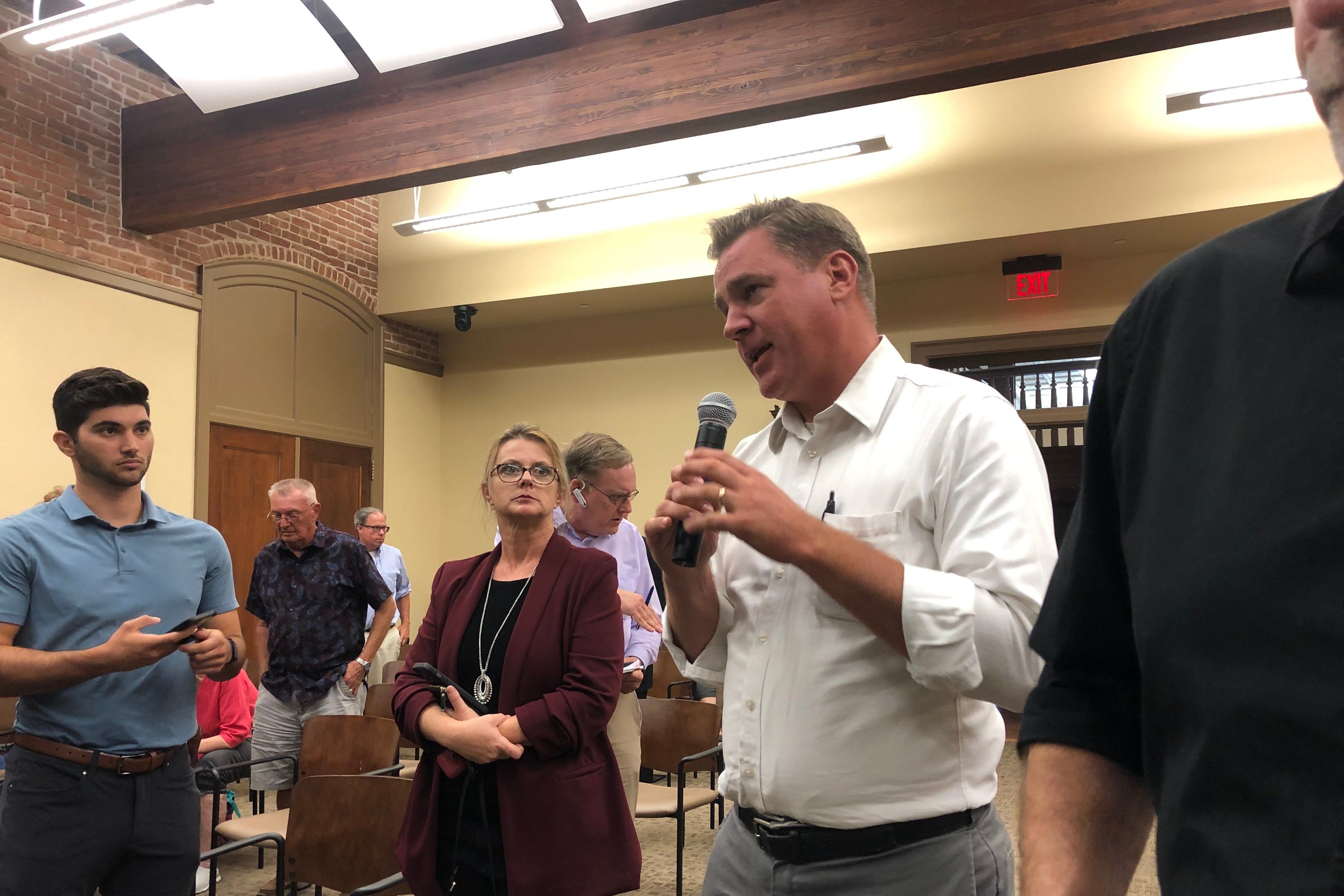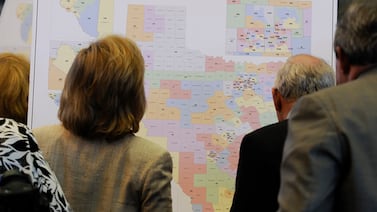In Pinal County earlier this month, some Election Day voters waited hours for a primary ballot at polling places that had run out. They grew frustrated waiting for printers in the election office to slowly spit out additional ballots that then had to be trucked to sites around the county.
Poll workers — already struggling because, they later said, they weren’t properly trained and didn’t have the tools to do their jobs — couldn’t do much about it. They couldn’t reach the county at times to ask for help, consistently encountering lengthy holds when they called a hotline.
The county supervisors were getting calls. Supervisor Mike Goodman went out and saw the frustration at polling sites around the county firsthand. He begged people not to leave, to wait in line as long as it took. But some left anyway, without casting a ballot.
Frustrations came to a head when one man grew so angry, he caused a disturbance at a polling place in a San Tan Valley school, according to the Pinal County Sheriff’s Office. He refused to leave and was arrested.
The county later determined that more than 20 precincts had ballot shortages on Election Day, leaving some voters to wait for hours to vote — or to simply give up.
Pinal’s debacle on Election Day came right on the heels of another huge screw-up: In July, the elections department sent out more than 60,000 early ballots that didn’t include town elections. Officials had to scramble to send a second set of ballots to those voters.
The county still can’t say how many people weren’t able to vote in the primary. No one knows whether those voters could have shifted the election outcomes, especially in close, local races farther down the ballot.
It’s now clear that Pinal County’s former elections director, who had only been on the job a few months and has since been fired, didn’t order nearly enough ballots to account for a largely Republican populace that’s increasingly wary of voting by mail.
But it’s also clear that no one factor was responsible and there were plenty of warning signs no one heeded. The county didn’t allocate enough resources for elections and failed to exercise full oversight of the office, even as rapid employee turnover prompted the hiring of inexperienced people who were struggling to communicate clearly.
“We could see months ahead of time that this was a train wreck in slow motion,” said Brenda Gifford, a Republican precinct captain who lives in the county.
At a packed public meeting this week, a parade of poll workers and observers spent several hours telling county supervisors about all kinds of problems at their polling sites: locked cages of supplies that didn’t come with keys, polling places that opened an hour or two late, minimal training to do their jobs properly, missing equipment, a phone line designed to help them that wasn’t answered.
Supervisors warned attendees not to applaud or heckle, but there were outbursts anyway — including a round of applause when Gifford called on the entire board and the county manager to resign.
“This has been a grand embarrassment,” said Jeffrey McClure, the chairman of the supervisors, acknowledging the election problems.
The county has installed a local, recognizable face as the new elections director: the recorder, Virginia Ross, who stepped down from her elected office to take over and rebuild the elections department.
She will have to reckon with the ways in which the county’s focus on creating a lean government, at low cost to taxpayers, backfired in the elections department, where even small errors can create massive distrust of a fundamental process.
“Because we were so lean, we had single points of failure. There [weren’t] redundancies, there wasn’t the ability to have people double-checking,” County Attorney Kent Volkmer told the county board.
The county’s election staff in 2022 was roughly the same size as when Ross first took office in 2013, even though the county’s registered voters increased from around 83,000 to about 275,000, Ross said. A lack of continuity and local experience in the elections department, and a lack of oversight and management by the county manager and supervisors, kept the department from reorganizing and growing at the same pace the county did.
With a growing county, and with such an important mission, the department should not have been stretched that thin, Supervisor Jeff Serdy said.
“If any department needs to be better taken care of, it’s obviously this department. Because this is such a sacred right. And this should never happen again because of that,” Serdy said.
Pinal, of course, is far from the only jurisdiction trying to do more with less. Across the country, elections are underfunded, understaffed, and under intense scrutiny, leading to turnover of experienced elections workers. One report from the Bipartisan Policy Center noted that elections were “chronically — and in some cases, haphazardly — underfunded.” This lack of funding “leads to antiquated technology and equipment, understaffed election offices, and overworked officials.”
Pinal County’s disasters show what voters across the country may soon face if the public doesn’t invest in elections.
At a time when partisans are prone to claim fraud, it’s imperative to provide resources for smooth elections that could prevent errors like the ones in Pinal, said Rachael Dean Wilson, the head of external affairs for the Alliance for Securing Democracy.
“We have a tendency to solve problems only after they emerge, not ahead of time,” she said. “But this is the moment, if we ever need to be very forward-thinking of the things that could go wrong in our elections and bolster them, now is the time.”
A barrage of problems on Election Day
In Pinal, every public discussion of the election problems has been tinged with frustration and anger. The day after the Aug. 2 primary, a board meeting and press conference showcased poll workers and candidates who demanded to know how their races — and their neighbors — were affected by the lapses.
Some threatened to file lawsuits, and at least a couple have. One, from Arizona Sen. Kelly Townsend, a Republican who lost her primary, sought an injunction to stop the canvassing of the election, though a hearing wasn’t set until after the Aug. 12 canvass deadline.
“How do we reconcile the harm that I see, not just to my own race, but to my voters? My neighbors were deeply disenfranchised,” Townsend said on Aug. 3.
In the days that followed, Ross, in her new position, tried to figure out what went wrong with the ballots. Her initial review found that the now-fired director, David Frisk, had modeled the number of in-person voters he was expecting by assuming the voters on the Active Early Voting List, who would automatically receive mailed ballots, wouldn’t vote in person. He then added a 1% buffer to the ballot supply totals.
Those calculations left the county massively short in some areas on Election Day.
Ross said someone with local knowledge and an understanding of Arizona GOP voters’ growing distrust of mailed ballots should have known to order far more, despite the number of voters on the list to receive mail ballots.
The county’s elections officials are each responsible for figuring out how many ballots to order. State statute says each precinct should print enough early and printed ballots to exceed at least 1% of registered voters in that precinct. The secretary of state’s office, in the elections procedures manual, suggests local officials take into account factors like previous turnout, number of voters, and past voting patterns when projecting turnout.
Ross said both Democrats and Republicans were affected by the shortages. The county, though, has far more Republicans than Democrats. Some poll workers said their sites ran out of Republican ballots in the morning.
To create more ballots on the fly, the county relied on two “antiquated” printers that could print just one ballot every three minutes, making 40 per hour, Volkmer, the county attorney, said. He said the county contacted its representative at Runbeck Election Services, which printed its ballots, but were told Runbeck couldn’t help because the county needed small batches across multiple precincts. Runbeck, however, told Votebeat it didn’t hear from the county, and that the company “would have been able to assist in printing additional ballots regardless of the size of the order.”
The county has so far said there’s no indication of criminal intent or illegality with the election problems. And officials don’t think any outside agency or group is to blame.
“It was fully within our [county],” Volkmer said. “Again, it was lean. There were single points of failure. We relied on a professional to our detriment.”
Brewing troubles behind the scenes
Long before Election Day, signs of distress in the department were bubbling up.
Frisk, the former elections director, wasn’t hired until March 2022. He came on board with a staff of two, one of whom was practically on their way out the door, while two new workers started later in March. His office lacked much local election experience, and they had five months to get up to speed and pull off a successful election.
Citizens who were active in local politics struggled to communicate with the department. Poll workers said they weren’t trained well on the equipment or procedures they’d need to follow in their roles.
“It was unbelievably understaffed. And we could all tell you that because we would call and call and call and call without any good outcome,” said Gifford, the Republican precinct captain.
Frisk was fired two days after the primary. A second worker in the office, who was still in their probationary period, was also fired this month, county spokesman James Daniels told Votebeat. That worker was not meeting expectations, he said.
Pinal’s separate elections office is relatively new. The county created it in 2017. Before that, the recorder was in charge. The change was spurred by the county’s growth, which made the job too big for one person, Ross said. She trusted the then-director, Michelle Forney, and communicated with her constantly.
“There are pros and cons” to splitting the operations, Ross said. “For an elected official, apparently, it’s double the work, and no extra pay,” because the state Legislature sets the pay for recorders.
Serdy, who wasn’t on the board when the split happened, questioned why the change was made at all. It seemed elections ran smoothly before, he said.
“I want to hear: Where did the breakdown start? Is it all the way back to 2017? Why didn’t we see this happen?” Serdy told Votebeat.
Forney left the job after the 2020 election for a position in the Nevada Secretary of State’s office. The county named an interim director, Stephanie Cooper. A group of residents urged the board last summer to promote an elections director from within instead of hiring from outside the community, saying it sent a good message about opportunities for advancement and ensured continuity in the office. Cooper applied for the permanent role, but wasn’t selected. She left at the end of 2021 to become the elections administrator in Hood County, Texas, as Pinal County searched for applicants for a permanent elections director.
The job drew few applicants.
“Before, when jobs were posted in the elections and recorder’s office, we would have 60 or 70 candidates. Then this year, you had maybe three or four. So there really wasn’t like a huge selection of people to look at,” Ross said.
Overall, 10 people applied, only four of whom had election experience, Daniels, the county spokesman, told Votebeat. One candidate dropped out of the running after accepting another job, and three were interviewed. The county hired Frisk.
The turnover meant the county hadn’t done long-term planning. The office needed to hire new people at a time of increased competitiveness for workers. Some could make more money by working remotely for Maricopa or Pima counties.
Ross has now created a revamped organizational chart with five new positions. That would bring the total number in the department up to 11, including her. The county will fund the positions by reallocating money from the general fund. Some positions could be filled internally, while others may be new hires, Daniels said.
Ross is also working to create more hands-on training for poll workers. She said she found outdated information and typos in the training manual, so it will be rewritten. She’s trying to return calls to people who weren’t getting good communication from the office for the past year.
For Wilson, of the Alliance for Securing Democracy, it’s critical to ensure election workers have gamed out possible scenarios ahead of an election. There should be proper oversight and plenty of checking each other’s work.
“I would just say training, training, training. You cannot train enough for Election Day,” she said.
Who’s to blame? Plenty to go around.
The county hired an outside expert to conduct an administrative review to figure out what caused the problems, how the problems were managed, and what could be done differently going forward. It will be conducted by Brad Nelson, who previously served as elections director in Pima County and, before that, Mohave County.
Some residents said merely putting the blame on David Frisk ignores the broader problems. He should have had oversight and training so he could be successful in his role, they say. The elections director reports to the county manager, who reports to the board.
“They’re making him the scapegoat for their leadership failure,” Gifford said.
Patrick Camunez, the county’s human resources director from 2016 to 2019, said elections employees had come to him with concerns over their pay, workloads, and equipment. The department was neglected by the county, he said. When he tried to raise concerns to county management, he would often hear “that’s just not something the board has an appetite for.”
The election staff “just didn’t feel like they were valued. They didn’t feel like they were listened to. They had brought up personnel issues. … They were kind of falling on deaf ears,” Camunez said.
Since the department was small, it became a “classic case of more and more work and more responsibility” for no additional pay, he said.
“The priority was we wanted to get the tax rate as close to zero as possible,” Camunez said.
Serdy, the supervisor, knows there are lessons to be learned from Pinal’s failures. “I think other counties and other places are watching us, too, so that they don’t make the same mistakes we make. History is important,” he said. “I have a smart TV on right now. And I watch a lot of channels and they’re talking about Pinal County all the time nationwide here lately, and I don’t like it.”
All eyes on Pinal
Before this year, the last time Pinal elections made big news was when the county’s elections warehouse burned to the ground in 2014, just 40 days before the primary election. Ross was recorder then, and the recorder still managed elections.
The county lost all its election equipment. People joked with her, saying that’s what she did to get new equipment.
She handled that crisis. This year’s mess, though, wasn’t caused by a server going up in flames. The systemic problems, and the mounting distrust from the community, will be difficult to overcome. So far, even the most heated commenters commended Ross for stepping in — if anyone can do it, they think it’s her. She knows there’s no room for any more mistakes.
“I pay attention to everything that goes on. I don’t feel that rusty,” she told Votebeat.
The board plans to update the public on progress improving the department at each of its meetings. The outside review should be done in 30-45 days. There’s another big election looming.
Already, the board voted to refund the cities and towns the costs of running the elections the county was contracted to handle — more than $100,000. While seven communities were affected by the first misprinting snafu — including Casa Grande and the City of Maricopa — the remaining communities, including Coolidge, had ballot shortages, Volkmer told the board. No community was unscathed.
Other costs associated with repairing the election are piling up: printing tens of thousands of additional local ballots, an outside administrative review, legal fees, additional staff, more communications to the public.
Skimping, it turns out, carries costs, both in dollars and distrust.
Sharing what went wrong and how it will be fixed is critical to regaining trust from the public after such a damaging series of problems, Securing Democracy’s Rachael Dean Wilson said.
“That is, all your cards on the table, this is what happened. This is where we went wrong. And then show up in the general election in November, and kind of prove to voters that they can pull this off,” she said.
Mike Goodman, the county supervisor who witnessed the polling place frustrations, doubts Pinal County is the only place having these problems, he said during the meeting this week. Every element of elections needs to be analyzed, with complete transparency to the public.
“We should be a poster child for other locations,” he said, “to be looking at what not to do, and start doing what they need to be doing to really straighten out the elections departments across this nation.”
Rachel Leingang is a freelancer for Votebeat and co-founder of the Arizona Agenda. Contact Rachel at rleingang@votebeat.org.






